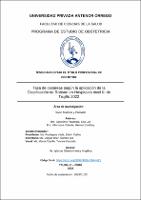Tasa de cesáreas según la aplicación de la Clasificación de Robson en Hospitales nivel III de Trujillo 2022

View/
Download
(application/pdf: 80.09Kb)
(application/pdf: 80.09Kb)
Date
2023Author(s)
Geronimo Plasencia, Lilia Luz
Villanueva Velarde, Heinter Estefany
Metadata
Show full item recordAbstract
El estudio tuvo como objetivo determinar la tasa de cesáreas según la aplicación
de la Clasificación de Robson en hospitales nivel III de Trujillo 2022, la
metodología empleó un enfoque cuantitativo, tipo descriptivo, diseño no
experimental, de corte transversal. La muestra fue de 3249 mujeres atendidas por
parto de enero a septiembre del 2022. Se utilizó una ficha de datos basada en la
Clasificación de Robson. Se recolectó la información del Sistema Informático
Perinatal. La tasa de cesárea para el Hospital Belén de Trujillo fue de 74,30%
(1402/1887) y los grupos con mayor contribución fueron 5, 1, 10 y 3, mientras que,
en el Hospital Regional Docente de Trujillo fue de 75, 26% (1025/1362) y los
grupos con mayor contribución fueron 5, 10, 1 y 3. En ambos hospitales, las
características socioculturales predominantes fueron: jóvenes, con secundaria y
convivientes, y en características obstétricas fueron: multíparas, a término,
categoría simple, sin antecedente de cesárea, feto en cefálica e inicio de parto
espontáneo. La Clasificación de Robson extenderá la tasa de cesáreas y los
grupos con mayor contribución al incremento sobre el parámetro de la OMS (15%). The objective of the study was to determine the rate of cesarean sections
according to the application of the Robson Classification in level III hospitals of
Trujillo 2022, the methodology used a quantitative approach, descriptive type, non experimental design, cross-sectional. The sample consisted of 3,249 women
attended for childbirth from January to September 2022. A data sheet based on
the Robson Classification was used. Information was collected from the Perinatal
Information System. The caesarean section rate for the Hospital Belén de Trujillo
was 74.30% (1402/1887) and the groups with the highest contribution were 5, 1,
10 and 3, while at the Hospital Regional Docente de Trujillo it was 75, 26%
(1025/1362) and the groups with the greatest contribution were 5, 10, 1 and 3. In
both hospitals, the predominant sociocultural characteristics were: young people,
with secondary education and cohabiting, and in obstetric characteristics they
were: multiparous, at term, simple category, with no history of cesarean section,
cephalic fetus and spontaneous onset of labor. The Robson Classification will
extend the rate of cesarean sections and the groups with the greatest contribution
to the increase over the WHO parameter (15%).
Collections
- Obstetricia [129]

